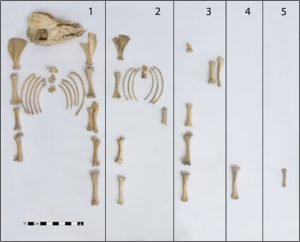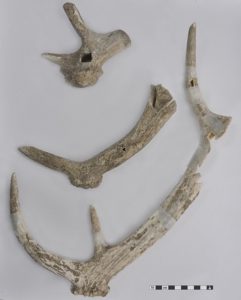The study of the terrestrial faunal remains aims to explore the relationship between humans and animals by examining a range of topics, namely the dietary choices through time of the inhabitants of Karabournaki, their cooking techniques, consumption practices, discard strategies, farming practices, exploitation of natural fauna and management of the domestic animals, and the effects of these practices on the socio-political organization of the settlement.
The terrestrial animals found at Karabournaki were mammals, reptiles and birds. The mammals included both domesticates (sheep, goat, cattle, pig, dog and donkey), which were heavily predominant, and wild (red deer, roe deer and hare), which were scarce. Reptiles were represented only by tortoise and birds only by mallard. Sheep, goat and cattle, as productive animals, along with pig, represented the pastoral economy of the settlement. Livestock products were destined for both domestic consumption and the market. Sheep, together with goat, were exploited mostly for their meat and fibre. Cattle were used mainly for meat and possibly traction, while pig was bred mainly for meat, with a preference for piglets (e.g. inside a structure of trench 27–89d were found remains from five piglets, Fig. 1). The wild species attest to hunting and, together with salt- and freshwater fish and shellfish (Tiverios et al 2013), indicate that the inhabitants of Karabournaki also exploited the surrounding environment (Gkotsinas 2021).

Most of the faunal remains were obtained mainly from the interior of refuse areas, namely pits and beehive-shaped semi-subterranean structures, which are dated in the Geometric to Classical periods (Tsiafakis 2010). The bone remains within each refuse area vary in terms of quantity, species, anatomical representation, and traces of pre- and post-depositional alteration. Taphonomic analysis suggests that the animal remains represent refuse from primary butchery (Fig. 2), food preparation and consumption.

In addition, some heavily burnt material had perhaps been used as fuel, while some specimens bore traces of working. The latter were mainly astragali of sheep, goat and cattle and shed antlers of red deer (Fig. 3). The animal bone remains were thus most probably derived from nearby households and butchers’ shops, although a few worked specimens may also have come from craft workshops (Gkotsinas 2021).

The study of the terrestrial animal remains from Karabournaki is important because knowledge of the pastoral economy in the first millennium BC in Northern Greece is rather fragmentary, as previous zooarchaeological studies were focused mostly on the Neolithic and Bronze Age periods. The study of the faunal assemblage from Karabournaki can provide valuable zooarchaeological evidence for 8th to 5th c. BC animal exploitation, thanks to the systematic excavation, collection and study of the remains. The results of this study will contribute to ongoing discussions regarding animal husbandry and mobility and the exploitation of natural resources during the first millennium BC in Northern Greece and the wider region of the Aegean basin.
Dr. Angelos Gkotsinas
References:
Gkotsinas, A. 2021. An Investigation of Iron Age to Classical Animal Bone Deposits in Northern Greece (Macedonia): Argilos, Karabournaki and Kastri Thassos. Unpublished PhD dissertation, University of Montpellier and University of Montreal.
Tiverios, M., Manakidou, E., Tsiafakis, D., Valamoti, S.-M., Theodoropoulou, T. & Gatzogia, E. 2013. Cooking in an Iron Age Pit at Karabournaki. An interdisciplinary approach. In: Voutsaki, S. & Valamoti, S.-M. (eds). Diet, Economy and Society in the Ancient Greek world. Towards a better integration of archaeology and science. Proceedings of the International Conference, Netherlands Institute at Athens, 22–24 March, Peeters, Leuven, 205–214.
Tsiafakis, D. 2010. Domestic Architecture in North Aegean: The Evidence from the ancient settlement in Karabournaki. In: Tréziny, H. (ed.) Bibliothèque d’Archéologie Méditerranéenne et Africaine 3 Grecs et Indigènes de la Catalogne à la Mer Noire. Actes des rencontres du programme européen Ramses2 (2006-2008). Paris: Éditions Errance Centre Camille Jullian, pp. 379-388.
